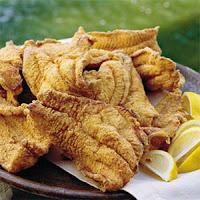Lent kicks off this week and tomorrow will be the first of seven Fridays that many people will commemorate by not eating meat. Whether or not you recognize the season in your home, you’ll notice that a lot of seafood goes on sale as a result.
<><><><><><><><><>
 |
| The season of the “fish fry” is here. Photo via wbean.blogspot.com |
Fish has numerous health benefits, and any dietitian will promote “more fish, less meat.” But, if you’re trying to balance health, economics, and ecological responsibility, the choices get a lot more complicated. For example, tuna is cheap, but the best cuts have high mercury levels, and the variety with the lowest mercury has the worst environmental record.
Then there’s the issue of wild vs. farmed. Which is better? (The answer: depends on the type of fish.) The last thing you want for Lent is an extra helping of guilt, so here are a few resources to help you.
First, how can you buy sustainable fish? Where do you get it? Here is a good article debunking “7 Myths of Sustainable Seafood,” written by a practicing nutritionist. Think that the fish behind the counter is always better than the stuff in the freezers? Think again.
So which fish should you buy? The Environmental Defense Fund has put together a handy pocket guide you can print up and take to the store. This guide lists popular fish alphabetically and lists specific varieties according to 3 categories: Eco-Best, Eco-Ok, and Eco-Worst. It also puts a heart next to those high in Omega-3’s and a warning red triangle next to those with high mercury levels (pregnant or new mamas, take note of those especially).
But what if you want more information or your tastes are more exotic than salmon or tilapia? (And why does no one talk about sustainable octopus?) The Monterrey Bay Aquarium website is a great resource for all things sustainable seafood, including a “search” function. Each type has a quick rating plus a longer segment that describes the fish, its history, and the current state of its population. They rank by “Best Choices,” “Good Alternatives,” and “Avoid.” You can also download a pocket guide from this website that is organized by region:
What about the budget issue? Rainbow trout is healthy and sustainable, and it’s my personal favorite, but it’s not cheap. One option is to stretch the seafood with breadcrumbs, making “burgers” or “cakes” instead of serving whole fillets. Or you can make a pasta or rice dish, with the “meat” as a flavoring. Tuna Alfredo, anyone?
But I think the best choice is to try new varieties in new ways. Don’t just stick to the usual salmon, tilapia, or tuna. Catfish—yes, catfish!—is a great alternative. It’s cheap, sustainable, American-made, and healthy. And the new farmed catfish does not have that intense “muddy” flavor like the stuff your grandpa used to catch in the family pond. Alton Brown dedicated an episode of “Good Eats” to the humble catfish, including 3 recipes that are linked in this informative article: Catfish Ceviche, Catfish Soup (a Thai-style dish), and of course, Southern Fried Catfish.
Ah, fried catfish. Happy Lent and happy eating, everyone!
Let’s connect on social media too:
Mumbling Mommy on Facebook
Mumbling Mommy on Twitter
Mumbling Mommy on Pinterest
Category: FoodTags: budget








